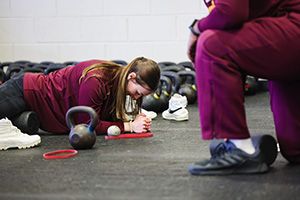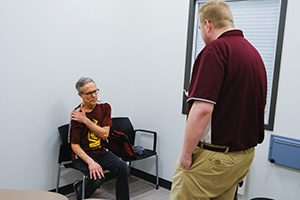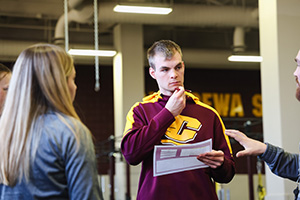Athletic training: Salary, career path and how to get started
If you're interested in sports, health and helping people perform at their best, a career as an athletic trainer might be the perfect fit. Do you want to work on the sidelines of sporting events or help patients recover from injuries? Athletic training will let you do just that with plenty of career opportunities for you to explore.
Explore athletic training at Central Michigan University and see how you can score a career you love where you'll help people on and off the field.
What does an athletic trainer do?
Athletic trainers are healthcare professionals who specialize in preventing, diagnosing and treating injuries and medical conditions related to physical activity. While people may assume they only work with athletes, their expertise goes beyond the playing field.
Common responsibilities of an athletic trainer include:
- Developing injury-prevention programs.
- Evaluating injuries on-site during practices or games.
- Providing immediate emergency care.
- Designing and overseeing rehabilitation plans.
- Educating athletes, patients and teams about health and wellness.
Athletic trainers often collaborate with doctors and physical therapists while on the job, making them an important part of the healthcare system. The ultimate goal is to keep athletes safe and healthy so they're able to perform at their best.
Athletic trainer salary
How much does an athletic trainer make? According to the U.S. Bureau of Labor Statistics, the average athletic trainer salary in 2024 is around $60,250 per year. The exact number varies based on other outside factors.
Here's a quick breakdown:
- Entry-level athletic trainers (right out of college): $45,000 - $50,000
- Mid-career trainers (5-10 years of experience): $55,000 - $65,000
- Senior-level trainers or those in specialized settings: $70,000 plus
Factors that affect salary:
- Location - Athletic trainers in larger cities or states with high demand may earn more.
- Industry - Trainers in professional sports can earn significantly more than those in high schools.
- Education level - A master's degree in athletic training often leads to higher salary and more job opportunities. Gaining certifications is another way to help increase your salary.
Athletic trainer jobs: Where can you work?
 One of the best things about a career in athletic training is the variety of places you can work. Athletic trainers aren't limited to sports teams.
One of the best things about a career in athletic training is the variety of places you can work. Athletic trainers aren't limited to sports teams.
Common work settings include:
- Colleges and universities - Supporting student-athletes.
- High schools - Helping younger athletes stay safe and recover from injuries.
- Professional sports - Working with professional athletes in the NFL, NBA, MLB and more.
- Hospitals and clinics - Supporting patient rehabilitation.
- Military and public safety - Keeping service members and first responders fit for duty.
With so many options, athletic training allows you to shape a career that fits your interests and passions!
How to become an athletic trainer
If you're excited about a potential career as an athletic trainer, the next step is figuring out how to become one. The process usually looks like this:
- Earn a bachelor's degree - Most students start with a degree in athletic training, exercise science or a related health field.
- Completing a master's degree - A master's degree in athletic training has become the standard for entering the profession.
- Pass the BOC exam - The BOC exam is a national certification exam that ensure you're qualified to practice.
- Get licensed (if required) - Many states require athletic trainers to be licensed or registered. Check the National Athletic Trainers Association (NATA) for your specific states requirements.
- Gain hands-on experience - Internships, clinical rotations and supervised training hours are critical for building real-world skills.
Tip: Choosing an established program with strong clinical placements and opportunities to gain connections in the industry makes a huge difference when starting your career.
Is athletic training right for you?
 If you like the idea of combining sports, medicine, patient care and training, this might be the career path for you! It's especially rewarding if you:
If you like the idea of combining sports, medicine, patient care and training, this might be the career path for you! It's especially rewarding if you:
- Enjoy working in fast-paced environments.
- Have strong communication and problem-solving skills.
- Want a career where you make a visible difference each day.
- Are passionate about health, fitness and rehabilitation.
It's also worth comparing athletic training to similar fields, such as physical therapy and exercise physiology. Athletic trainers tend to focus on immediate injury care and prevention, while physical therapists often handle longer-term recovery.
Why choose Central Michigan University for athletic training?
Our athletic training program, accredited by the Commission on Accreditation of Athletic Training Education , was the first sports medicine major of its kind in the United States.
You won't just sit in lectures, you'll be caring for patients early in your academic journey. You'll participate in courses like anatomy, nutrition, injury prevention and therapeutic rehabilitation. You will also have the opportunity to get hands-on experience with college and high-school sports teams, CMU's recreational facilities and local fitness centers.
What makes CMU's program stand out:
 Small class sizes - With no more than 16 students per class, you'll get personal attention from educators.
Small class sizes - With no more than 16 students per class, you'll get personal attention from educators.- Early clinical experience - You'll start working with patients and athletes right way, not just in your final semesters.
- A 3+2 program - In just five years, you'll earn both a Bachelor of Science in Athletic Training (BSAT) and a Master of Science in Athletic Training (MSAT).
- Preparation for certification - This program is built to prepare you for the BOC exam, helping you become a licensed athletic trainer.
Your future in athletic training
The demand for athletic trainers is expected to grow 13% by 2033, much faster than the national average for most professions. As schools, healthcare facilities, sports organizations and more continue to prioritize injury prevention and wellness, the need for skilled trainers will also increase.
That means more opportunities, higher salaries and a career path that is both stable and meaningful!